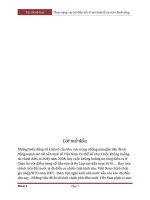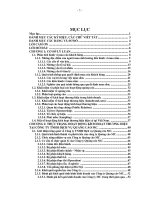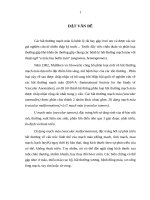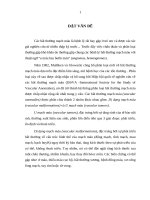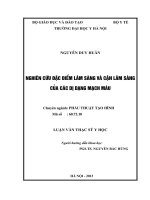CHAPTER 18: SỰ ĐIỀU TIẾT CỦA THẦN KINH VÀ KIỂM SOÁT NHANH ÁP SUẤT ĐỘNG MẠCH
Bạn đang xem bản rút gọn của tài liệu. Xem và tải ngay bản đầy đủ của tài liệu tại đây (377.38 KB, 10 trang )
CHAPTER 18: SỰ ĐIỀU TIẾT CỦA THẦN KINH VÀ KIỂM SOÁT NHANH ÁP SUẤT
ĐỘNG MẠCH.
Sự điều tiết của thần kinh trên phạm vi toàn bộ cơ thể, như tái phân phối dòng máu tới
các vùng cơ thể, tăng hay giảm hoạt động của bơm tim, và cung cấp nhanh việc điều hòa
của huyết áp.
Hệ thống thần kinh kiểm soát hệ tuần hoàn thông qua hệ thần kinh tự chủ(autonomic
nervous).
+ hệ thống thần kinh tự chủ: cho đến nay thì phần quan trọng nhất của sự điều tiết hệ
tuần hoàn là của hệ thống thần kinh giao cảm. Tuy nhiên hệ
thống đối giao cảm cũng có đóng góp quan trọng vào điều
hòa chức năng của tim.
- Hệ thần kinh giao cảm:
Sợi thần kinh giao cảm vận mạch rời tủy sống qua tất cả các dây thần kinh ngực và dây thắt lưng
1 và 2. Rồi thì chúng đi trong bó giao cảm, một nằm trong cột sống. Tiếp theo, chúng trải ra hai
đường tới tuần hoàn:(1)qua sợi thần kinh giao cảm đặc biệt phân phối chính ở nội tạng và tim;(2)
số khác chạy trong cột sống phân phối ở ngoại biên.
Sự phân phối thần kinh giao cảm ở mạch
Giao cảm phân phối ở hầu như tất cả các mô và mạch máu ngoại trừ mao mạch. Các cơ thắt tiền
mao mạch và tiểu động mạch được phân phối ở các mô, như mạc treo ruột, mặc dù sự phân phối
giao cảm thường không nhiều và dỳ đặc như ở động mạch nhỏ, động mạch và tĩnh mạch.
Sự phân phối của tới các động mạch nhỏ và động mạch cho phép sựu kích thích giao cảm làm
tăng sự háng cự của máu(resistance) và giảm tỷ lệ dòng máu qua mô.
Sự phan phối ở các mạch máu lớn, đặc biệt là ở tĩnh mạch, làm giảm thể tích của lòng mạch.
Điều này có thể đẩy máu đi về tim và bằng cách ấy mà nó có vai trò chính trong điều hòa bơm
tim.
Sợi thần kinh giao cảm tới tim
Vài sợi giao cảm đến tim trực tiếp, làm tăng hoạt động của tim, cả tăng nhịp và lực co cơ tim thể
tích bơm.
Thần kinh đối giao cảm điều hòa chức năng của tim, đặc biệt là nhịp tim
Mặc dù đối giao cảm cực kỳ quan trọng với chức năng tự chủ của cơ thể, như điều hòa hoạt động
tiêu hóa, nó chỉ giữ vai trò phụ trong điều hòa chức năng mạch máu. Nhưng nó có ảnh hưởng
quan trọng trong nhịp tim vì dây thần kinh mê tẩu(vagus nerves). Kích thích đối giao cảm gây
giảm nhịp tim và lực co cơ tim.
Hệ thống giao cảm co mạch và sự kiểm soát bởi hệ thần kinh trung ương
Sợi giao cảm mang số lượng cực kỳ nhiều sợi co mạch và chỉ số ít sợi dãn mạch. Sợi co mạch
được phân bố ở tất cả các phần chính của hệ tuần hoàn, nhưng có một số mô thì nhiều hơn ở nới
khác. Ảnh hưởng của giao cảm lên sức mạnh của thận, ruột, lách và da nhưng lại có ít trong cơ
xương và não.
Trung tâm vận mạch ở não và sự điều hòa của hệ thống co cơ
Được đặt song song với hành não và 1/3 dưới của cầu não là vùng gọi là trung tâm vận
mạch(vasomotor). Trung tâm này truyền đối giao cảm đến dây thần kinh mê tẩu tới tim và truyền
giao cảm tới tủy sống và giao cảm ngoại biên tới các động mạch, tiểu động mạch và tĩnh mạch
của cơ thể.
Mặc dù tổng cơ quan của trung tâm vận mạch vẫn chưa biết rõ, những trải nghiệm có được nhận
ra sự quan trọng của trung tâm này là:
1. Vùng co mạch được đặt song song trước bên hành não trên. Sự khởi đầu dây thần kinh
của vùng này được phân phối tới tất cả các bậc của tủy sống, nơi kích thích trước hạch
của những neuron co mạch của thần kinh giao cảm.
2. Vùng dãn mạch được đặt song song trước bên hành não dưới.
3. Vùng cảm giác(A sensory area located bilaterally in the tractus solitarius in the
posterolateral portions of the medulla and lower pons) nhận tín hiệu cảm giác của hệ tuần
hoàn qua dây mê tẩu và thần kinh thiệt hầu, giúp điều khiển hoạt động của cả hai vung co
cơ và dãn cơ của trung tâm vận mạch, vì vậy cung cấp sự phản xạ điều khiển nhiều chức
năng cảu hệ tuần hoàn.
Sự co sơ cục bộ liên tục của mạch máu là trường hợp bình thường gây ra nhịp nhàng bởi thần
kinh giao cảm.
Dưới điều kiện bình thường, vùng co mạch truyền tín hiệu liên tục tới sợi giao cảm co mạch đi
khắp cơ thể, gây ra sự co mạch cục bộ khoảng 0,5-2 xung /giây. Sự phát xung như vậy gọi là
nhịp điệu co mạch giao cảm (sympathetic vasoconstrictor tone). Sự kích thích bình thường duy
trì trạng thái co dãn mạch cục bộ được gọi là nhịp điệu co mạch tự chủ(vasomotor tone).
Điều hòa hoạt động của tim bởi trung tâm vận mạch
Đoạn sau của trung tâm vận mạch truyền kích thích tới dây giao cảm tới tim khi cần tăng nhịp
tim và co cơ. Ngược lại, khi cần giảm nhịp tim, đoạn giữa của trung tâm vận mạch gửi tín hiệu
tới trung tâm tự động mặt lưng của dây mê tẩu, truyền đối giao cảm qua day mê tẩu tới tim và
giảm nhịp và lực co cơ.
Điều hòa trung tâm vận mạch bởi vùng cao hơn của thần kinh trung ương
số lượng lớn cảu các neuron nhỏ được đặt mạng lưới của cầu não, não giữa và não bên cũng có
thể kích thích hay ức chế trung tâm vận mạch.
Vùng não điều khiển thân nhiệt đói khát(hypothalamus) có vai trò đặc biệt trong hệ thống co
mạch vì nó cũng có thể kích thích hay ức chế ảnh hưởng của trung tâm vận mạch.
(The hypothalamus plays a special role in controlling the vasoconstrictor system because it can
exert either powerful excitatory or inhibitory effects on the vasomotor center. The posterolateral
portions of the hypothalamus cause mainly excitation, whereas the anterior portion can cause
either mild excitation or inhibition, depending on the precise part of the anterior hypothalamus
stimulated.
Many parts of the cerebral cortex can also excite or inhibit the vasomotor center. Stimulation
of the motor cortex, for instance, excites the vasomotor center because of impulses transmitted
downward into the hypothalamus and then to the vasomotor center. Also, stimulation of the
anterior temporal lobe, the orbital areas of the frontal cortex, the anterior part of the cingulate
gyrus, the amygdala, the septum, and the hippocampus can all either excite or inhibit the
vasomotor center, depending on the precise portions of these areas that are stimulated and on
the intensity of stimulus. Thus, widespread basal areas of the brain can have profound effects
on cardiovascular function. )
Chất gây co mạch của giao cảm(norepinephrine)
Được tiết ra từ tận cùng đầu dây thần kinh co mạch hoàn toàn là epinephrine, tác động trực tiếp
lên thụ thể alpha (alpha adrenergic receptor) của cơ trơn mạch máu gây co mạch.
Tủy thượng thận và mối liên hệ với tk giao cảm
Thần kinh giao cảm được truyền bởi tủy thượng thận trong một vài thời gian rồi truyền tới
mạch máu. Chúng làm tủy thượng thận tiết ra hai loại hormone epinephrine và norepineephrine
vào máu. Cả hai đều được mang đến khắp nơi trong cơ thể và chúng tác động trực tiếp trên
mạch máu gây co mạch. Ở vài mô, epineephrine gây dãn mạch vì chúng tác động lên thụ thể
beta(beta adrenergic receptor).
Hệ thống dãn mạch giao cảm và được điều hòa bởi tk trung ương
Sợi giao cảm tới cơ xương là những sợi dãn cơ, hơn là những sợi co cơ. Một số động vật như
mèo, sợi dãn cơ tiết acetylcholine, không tiết norepinephrine ở tận cùng đầu dây tk, mặc dù
vậy nhưng ảnh hưởng dãn cơ được tin là do epinephrine tác dụng lên beta receptor trong cơ.
Vùng trước hạ đồi điều khiển hệ thống này.
- Hệ thống giao cảm dãn mạch có thể gây dãn cơ vân ban đầu cho phép tăng trước kì hạn
của dòng máu trước khi cơ đòi hỏi dưỡng chất.
Xúc động và hôn mê: đặc biệt ở một số người dãn mạch được phản ứng lại khi họ trải qua
xúc động mạnh gây ra ngất. Trong case như vậy, hệ thống dãn cơ trở nên hoạt động, trong
vài lần, trung tâm ức chế tim mạch thuộc tk mê tẩu truyền tín hiệu mạnh tới tim để giảm
dòng máu rõ rệt. Áp suất tĩnh mạch giảm nhanh, giảm dòng máu tói não và gây ra mất ý
thức. Được gọi là hôn mê(vasovagal syncope).
Vai trò của hệ thần kinh trong việc làm tăng nhanh huyết áp
Vì mục đích này, toàn bộ chức năng co mạch và tăng nhịp tim của giao cảm được kích thích
cùng lúc. Lúc này có sự ức chế lẫn nhau của đối giao cảm. Vì vậy, có 3 thay đổi chính xảy ra,
giúp tăng huyết áp:
1. Hầu hết các tiểu động mạch co cơ. Tăng tổng trở ngoại vi hay hậu tải.
2. Tĩnh mạch(nhất là các tĩnh mạch lớn) co cơ mạnh. Co cơ tĩnh mạch làm dòng máu
trở về tim nhiều hơn làm tăng tiền tải.
3. Cuối cùng, chính tim bị kích thích bởi thần kinh tự động tăng co bóp tim. Gây tăng
nhịp tim. Nhịp tim trong một số trường hợp có thể tăng gấp 3 lần bình thường.
Thêm vào đó tín hiệu thần kinh giao cảm còn làm tăng lực co cơ, vì vậy làm tăng
khả năng bóp máu với thể tích lớn của tim. Có thể bơm lượng máu gấp đôi bình
thường khi bị kích thích giao cảm như vậy. Những ddiffu này làm tăng tức thì huyết
áp.
Cơ chế phản xạ để duy trì huyết áp bình thường
Ngoài những khi hoạt động thể lực hay stress, chức năng của thần kinh tự động gây tăng huyết
áp, còn đối với những điều kiện bình thường nó có cơ chế tự nhiên là giữ ổn định huyết áp.
Một cơ chế phản xạ ngược âm tính:
Các áp thụ cảm(baroreceptor): cơ chế thần kinh điều hòa cho huyết áp phụ thuộc nhiều vào
các baroreceptor. Chúng được đặt ở những điểm đặc biệt trên thành của các động mạch lớn.
-
-
Việc tăng huyết áp làm căng duỗi các baroreceptor và gây truyền tín hiệu tới thần kinh
trung ương. Tín hiệu Feedback gửi ngược trở lại thần kinh tự chủ để giảm huyết áp
xuống mức bình thường.
Áp thụ cảm là tận cùng của nhánh thần kinh nhỏ và chúng bị kích thích khi bị làm căng
ra. Một vài baroreceptor trên thành mạch của động mạch lớn ở vùng ngực và cổ. Chúng
cực kì nhiều ở(1) nơi phân nhánh của động mạch cảnh, (2) thành của cung động mạch
chủ.
Figure 18-5 shows that signals from the "carotid baroreceptors" are transmitted through small
Hering's nerves to the glossopharyngeal nerves in the high neck, and then to the tractus
solitarius in the medullary area of the brain stem. Signals from the "aortic baroreceptors" in the
arch of the aorta are transmitted through the vagus nerves also to the same tractus solitarius of
the medulla.
Response of the Baroreceptors to Arterial Pressure
Circulatory Reflex Initiated by the Baroreceptors
After the baroreceptor signals have entered the tractus solitarius of the medulla, secondary
signals inhibit the vasoconstrictor center of the medulla and excite the vagal parasympathetic
center. The net effects are (1) vasodilation of the veins and arterioles throughout the peripheral
circulatory system and (2) decreased heart rate and strength of heart contraction. Therefore,
excitation of the baroreceptors by high pressure in the arteries reflexly causes the arterial
pressure to decrease because of both a decrease in peripheral resistance and a decrease in cardiac
output. Conversely, low pressure has opposite effects, reflexly causing the pressure to rise back
toward normal.
Function of the Baroreceptors During Changes in Body Posture
The ability of the baroreceptors to maintain relatively constant arterial pressure in the upper body
is important when a person stands up after having been lying down. Immediately on standing, the
arterial pressure in the head and upper part of the body tends to fall, and marked reduction of this
pressure could cause loss of consciousness. However, the falling pressure at the baroreceptors
elicits an immediate reflex, resulting in strong sympathetic discharge throughout the body. This
minimizes the decrease in pressure in the head and upper body.
Pressure "Buffer" Function of the Baroreceptor Control System
Because the baroreceptor system opposes either increases or decreases in arterial pressure, it is
called a pressure buffer system and the nerves from the baroreceptors are called buffer nerves.
Figure 18-8 shows the importance of this buffer function of the baroreceptors. The upper record
in this figure shows an arterial pressure recording for 2 hours from a normal dog, and the lower
record shows an arterial pressure recording from a dog whose baroreceptor nerves from both the
carotid sinuses and the aorta had been removed. Note the extreme variability of pressure in the
denervated dog caused by simple events of the day, such as lying down, standing, excitement,
eating, defecation, and noises.
Are the Baroreceptors Important in Long-Term Regulation of Arterial Pressure?
Although the arterial baroreceptors provide powerful moment-to-moment control of arterial
pressure, their importance in long-term blood pressure regulation has been controversial. One
reason that the baroreceptors have been considered by some physiologists to be relatively
unimportant in chronic regulation of arterial pressure chronically is that they tend to reset in 1 to
2 days to the pressure level to which they are exposed. That is, if the arterial pressure rises from
the normal value of 100 mm Hg to 160 mm Hg, a very high rate of baroreceptor impulses are at
first transmitted. During the next few minutes, the rate of firing diminishes considerably; then it
diminishes much more slowly during the next 1 to 2 days, at the end of which time the rate of
firing will have returned to nearly normal despite the fact that the mean arterial pressure still
remains at 160 mm Hg. Conversely, when the arterial pressure falls to a very low level, the
baroreceptors at first transmit no impulses, but gradually, over 1 to 2 days, the rate of
baroreceptor firing returns toward the control level.
This "resetting" of the baroreceptors may attenuate their potency as a control system for
correcting disturbances that tend to change arterial pressure for longer than a few days at a time.
Experimental studies, however, have suggested that the baroreceptors do not completely reset
and may therefore contribute to long-term blood pressure regulation, especially by influencing
sympathetic nerve activity of the kidneys. For example, with prolonged increases in arterial
pressure, the baroreceptor reflexes may mediate decreases in renal sympathetic nerve activity
that promote increased excretion of sodium and water by the kidneys. This, in turn, causes a
gradual decrease in blood volume, which helps to restore arterial pressure toward normal. Thus,
long-term regulation of mean arterial pressure by the baroreceptors requires interaction with
additional systems, principally the renal-body fluid-pressure control system (along with its
associated nervous and hormonal mechanisms), discussed in Chapters 19 and 29.
Control of Arterial Pressure by the Carotid and Aortic Chemoreceptors-Effect of Oxygen Lack
on Arterial Pressure
Closely associated with the baroreceptor pressure control system is a chemoreceptor reflex that
operates in much the same way as the baroreceptor reflex except that chemoreceptors, instead of
stretch receptors, initiate the response.
The chemoreceptors are chemosensitive cells sensitive to oxygen lack, carbon dioxide excess,
and hydrogen ion excess. They are located in several small chemoreceptor organs about 2
millimeters in size (two carotid bodies, one of which lies in the bifurcation of each common
carotid artery, and usually one to three aortic bodies adjacent to the aorta). The chemoreceptors
excite nerve fibers that, along with the baroreceptor fibers, pass through Hering's nerves and the
vagus nerves into the vasomotor center of the brain stem.
Each carotid or aortic body is supplied with an abundant blood flow through a small nutrient
artery, so the chemoreceptors are always in close contact with arterial blood. Whenever the
arterial pressure falls below a critical level, the chemoreceptors become stimulated because
diminished blood flow causes decreased oxygen, as well as excess buildup of carbon dioxide and
hydrogen ions that are not removed by the slowly flowing blood.
The signals transmitted from the chemoreceptors excite the vasomotor center, and this elevates
the arterial pressure back toward normal. However, this chemoreceptor reflex is not a powerful
arterial pressure controller until the arterial pressure falls below 80 mm Hg. Therefore, it is at the
lower pressures that this reflex becomes important to help prevent further decreases in arterial
pressure.
The chemoreceptors are discussed in much more detail in Chapter 41 in relation to respiratory
control, in which they play a far more important role than in blood pressure control.
Atrial and Pulmonary Artery Reflexes Regulate Arterial Pressure
Both the atria and the pulmonary arteries have in their walls stretch receptors called low-pressure
receptors. They are similar to the baroreceptor stretch receptors of the large systemic arteries.
These low-pressure receptors play an important role, especially in minimizing arterial pressure
changes in response to changes in blood volume. For example, if 300 milliliters of blood
suddenly are infused into a dog with all receptors intact, the arterial pressure rises only about 15
mm Hg. With the arterial baroreceptors denervated, the pressure rises about 40 mm Hg. If the
low-pressure receptors also are denervated, the arterial pressure rises about 100 mm Hg.
Thus, one can see that even though the low-pressure receptors in the pulmonary artery and in the
atria cannot detect the systemic arterial pressure, they do detect simultaneous increases in
pressure in the low-pressure areas of the circulation caused by increase in volume, and they elicit
reflexes parallel to the baroreceptor reflexes to make the total reflex system more potent for
control of arterial pressure.
Atrial Reflexes That Activate the Kidneys-The "Volume Reflex."
Stretch of the atria also causes significant reflex dilation of the afferent arterioles in the kidneys.
Signals are also transmitted simultaneously from the atria to the hypothalamus to decrease
secretion of antidiuretic hormone (ADH). The decreased afferent arteriolar resistance in the
kidneys causes the glomerular capillary pressure to rise, with resultant increase in filtration of
fluid into the kidney tubules. The diminution of ADH diminishes the reabsorption of water from
the tubules. Combination of these two effects-increase in glomerular filtration and decrease in
reabsorption of the fluid-increases fluid loss by the kidneys and reduces an increased blood
volume back toward normal. (We will also see in Chapter 19 that atrial stretch caused by
increased blood volume also elicits a hormonal effect on the kidneys-release of atrial natriuretic
peptide-that adds still further to the excretion of fluid in the urine and return of blood volume
toward normal.)
All these mechanisms that tend to return the blood volume back toward normal after a volume
overload act indirectly as pressure controllers, as well as blood volume controllers, because
excess volume drives the heart to greater cardiac output and leads, therefore, to greater arterial
pressure. This volume reflex mechanism is discussed again in Chapter 29, along with other
mechanisms of blood volume control.
Atrial Reflex Control of Heart Rate (the Bainbridge Reflex)
An increase in atrial pressure also causes an increase in heart rate, sometimes increasing the heart
rate as much as 75 percent. A small part of this increase is caused by a direct effect of the
increased atrial volume to stretch the sinus node; it was pointed out in Chapter 10 that such direct
stretch can increase the heart rate as much as 15 percent. An additional 40 to 60 percent increase
in rate is caused by a nervous reflex called the Bainbridge reflex. The stretch receptors of the
atria that elicit the Bainbridge reflex transmit their afferent signals through the vagus nerves to
the medulla of the brain. Then efferent signals are transmitted back through vagal and
sympathetic nerves to increase heart rate and strength of heart contraction. Thus, this reflex helps
prevent damming of blood in the veins, atria, and pulmonary circulation.
Central Nervous System Ischemic Response-Control of Arterial Pressure by the Brain's
Vasomotor Center in Response to Diminished Brain Blood Flow
Most nervous control of blood pressure is achieved by reflexes that originate in the
baroreceptors, the chemoreceptors, and the low-pressure receptors, all of which are located in the
peripheral circulation outside the brain. However, when blood flow to the vasomotor center in
the lower brain stem becomes decreased severely enough to cause nutritional deficiency-that is,
to cause cerebral ischemia-the vasoconstrictor and cardioaccelerator neurons in the vasomotor
center respond directly to the ischemia and become strongly excited. When this occurs, the
systemic arterial pressure often rises to a level as high as the heart can possibly pump. This effect
is believed to be caused by failure of the slowly flowing blood to carry carbon dioxide away
from the brain stem vasomotor center: At low levels of blood flow to the vasomotor center, the
local concentration of carbon dioxide increases greatly and has an extremely potent effect in
stimulating the sympathetic vasomotor nervous control areas in the brain's medulla.
It is possible that other factors, such as buildup of lactic acid and other acidic substances in the
vasomotor center, also contribute to the marked stimulation and elevation in arterial pressure.
This arterial pressure elevation in response to cerebral ischemia is known as the central nervous
system (CNS) ischemic response.
The ischemic effect on vasomotor activity can elevate the mean arterial pressure dramatically,
sometimes to as high as 250 mm Hg for as long as 10 minutes. The degree of sympathetic
vasoconstriction caused by intense cerebral ischemia is often so great that some of the
peripheral vessels become totally or almost totally occluded. The kidneys, for instance, often
entirely cease their production of urine because of renal arteriolar constriction in response to the
sympathetic discharge. Therefore, the CNS ischemic response is one of the most powerful of all
the activators of the sympathetic vasoconstrictor system.
Importance of the CNS Ischemic Response as a Regulator of Arterial Pressure
Despite the powerful nature of the CNS ischemic response, it does not become significant until
the arterial pressure falls far below normal, down to 60 mm Hg and below, reaching its greatest
degree of stimulation at a pressure of 15 to 20 mm Hg. Therefore, it is not one of the normal
mechanisms for regulating arterial pressure. Instead, it operates principally as an emergency
pressure control system that acts rapidly and very powerfully to prevent further decrease in
arterial pressure whenever blood flow to the brain decreases dangerously close to the lethal
level. It is sometimes called the "last ditch stand" pressure control mechanism.
Cushing Reaction to Increased Pressure Around the Brain
The so-called Cushing reaction is a special type of CNS ischemic response that results from
increased pressure of the cerebrospinal fluid around the brain in the cranial vault. For instance,
when the cerebrospinal fluid pressure rises to equal the arterial pressure, it compresses the whole
brain, as well as the arteries in the brain, and cuts off the blood supply to the brain. This initiates
a CNS ischemic response that causes the arterial pressure to rise. When the arterial pressure has
risen to a level higher than the cerebrospinal fluid pressure, blood will flow once again into the
vessels of the brain to relieve the brain ischemia. Ordinarily, the blood pressure comes to a new
equilibrium level slightly higher than the cerebrospinal fluid pressure, thus allowing blood to
begin again to flow through the brain. The Cushing reaction helps protect the vital centers of the
brain from loss of nutrition if ever the cerebrospinal fluid pressure rises high enough to compress
the cerebral arteries.
